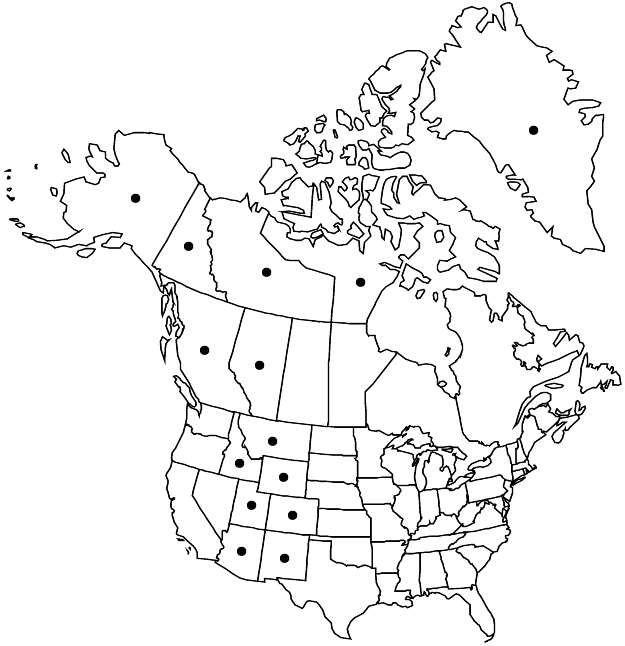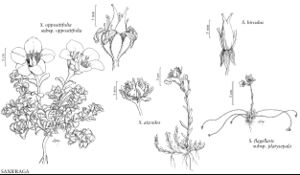Saxifraga flagellaris
in C. M. von Sternberg, Revis. Saxifrag. 1: 25, plate 6. 1810 ,.
Plants in solitary clumps, stoloniferous, slenderly rhizomatous. Leaves basal and cauline; petiole absent; blade oblong-lanceolate or elliptic to obovate, unlobed, 5–20 mm, fleshy, margins entire, sparsely to densely, coarsely glandular-ciliate, distal sometimes ciliate, apex acute to ± obtuse, mucronate, surfaces glabrous. Inflorescences 2–3 (–5) -flowered, lax cymes, sometimes solitary flowers, 1–15 cm, densely purplish-tipped stipitate-glandular; bracts sessile. Flowers: sepals erect, elliptic or oblong-ovate, margins stipitate glandular-ciliate, surfaces stipitate-glandular; petals yellow, not spotted, elliptic to broadly obovate, 4–9 (–10) mm, longer than sepals; ovary superior to ca. 1/2 inferior.
Distribution

Alta., B.C., N.W.T., Nunavut, Yukon, Alaska, Ariz., Colo., Idaho, Mont., N.Mex., Utah, Wyo., Asia (c Asia), Asia (Caucasus), Asia (Russian Far East), Asia (Siberia), Atlantic Islands (Svalbard)
Discussion
Subspecies ca. 8 (3 in the flora).
Although sometimes reported from North America, subspecies flagellaris is not present in the flora area; it is native in Eurasia.
Selected References
None.
Lower Taxa
Key
| 1 | Ovaries superior; inflorescence bract blades shorter than internodes. | Saxifraga flagellaris subsp. setigera |
| 1 | Ovaries at least 1/2 inferior; inflorescence bract blades longer than internodes | > 2 |
| 2 | Inflorescences (2-)4-15 cm; hypanthia and sepals whitish- and black-tipped stipitate-glandular; petals elliptic to narrowly obovate, length to 2 times sepals. | Saxifraga flagellaris subsp. crandallii |
| 2 | Inflorescences 1-4(-6) cm; hypanthia and sepals black-tipped stipitate-glandular; petals broadly obovate, length 2+ times sepals. | Saxifraga flagellaris subsp. platysepala |
"full" is not a number.
